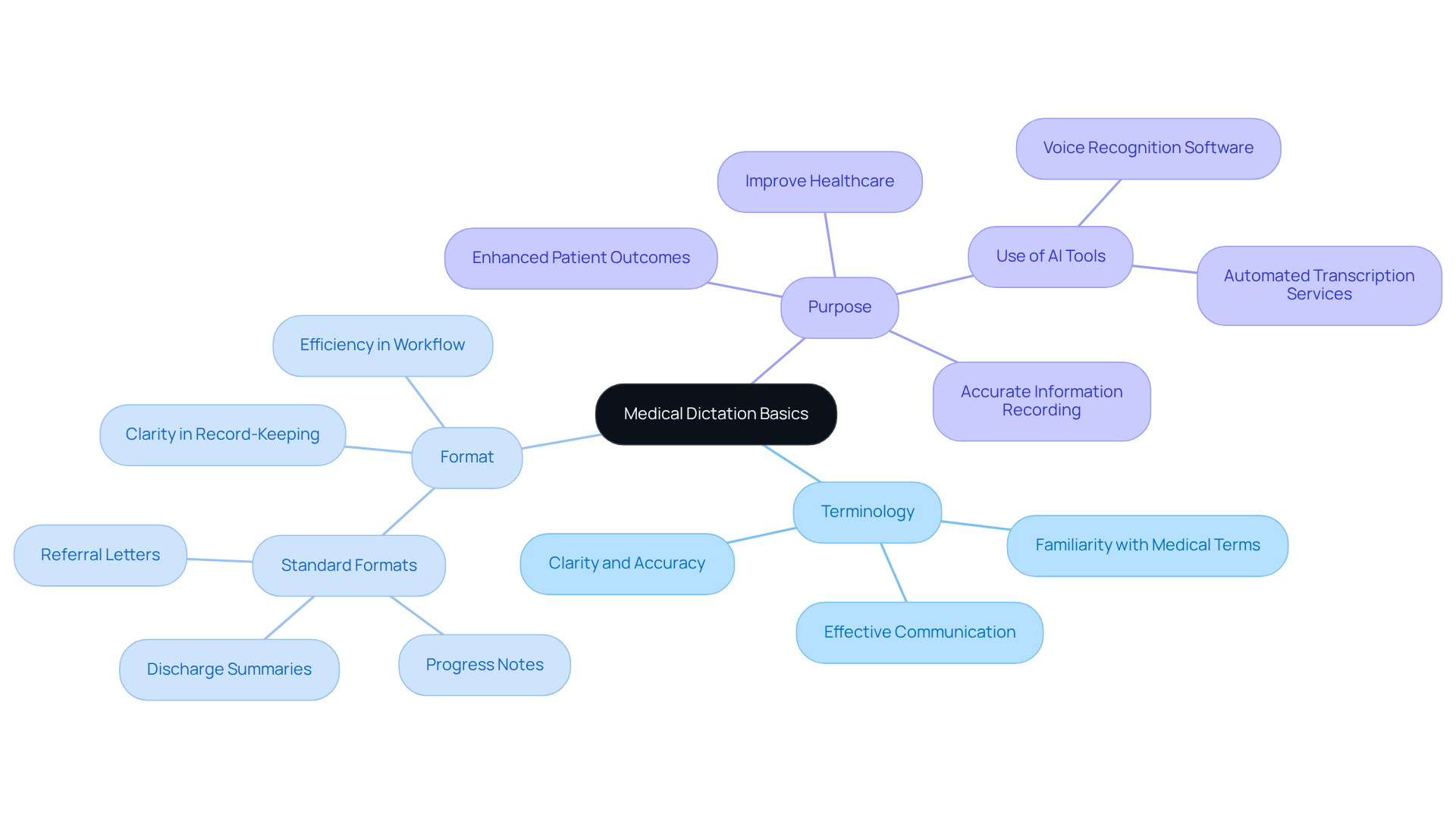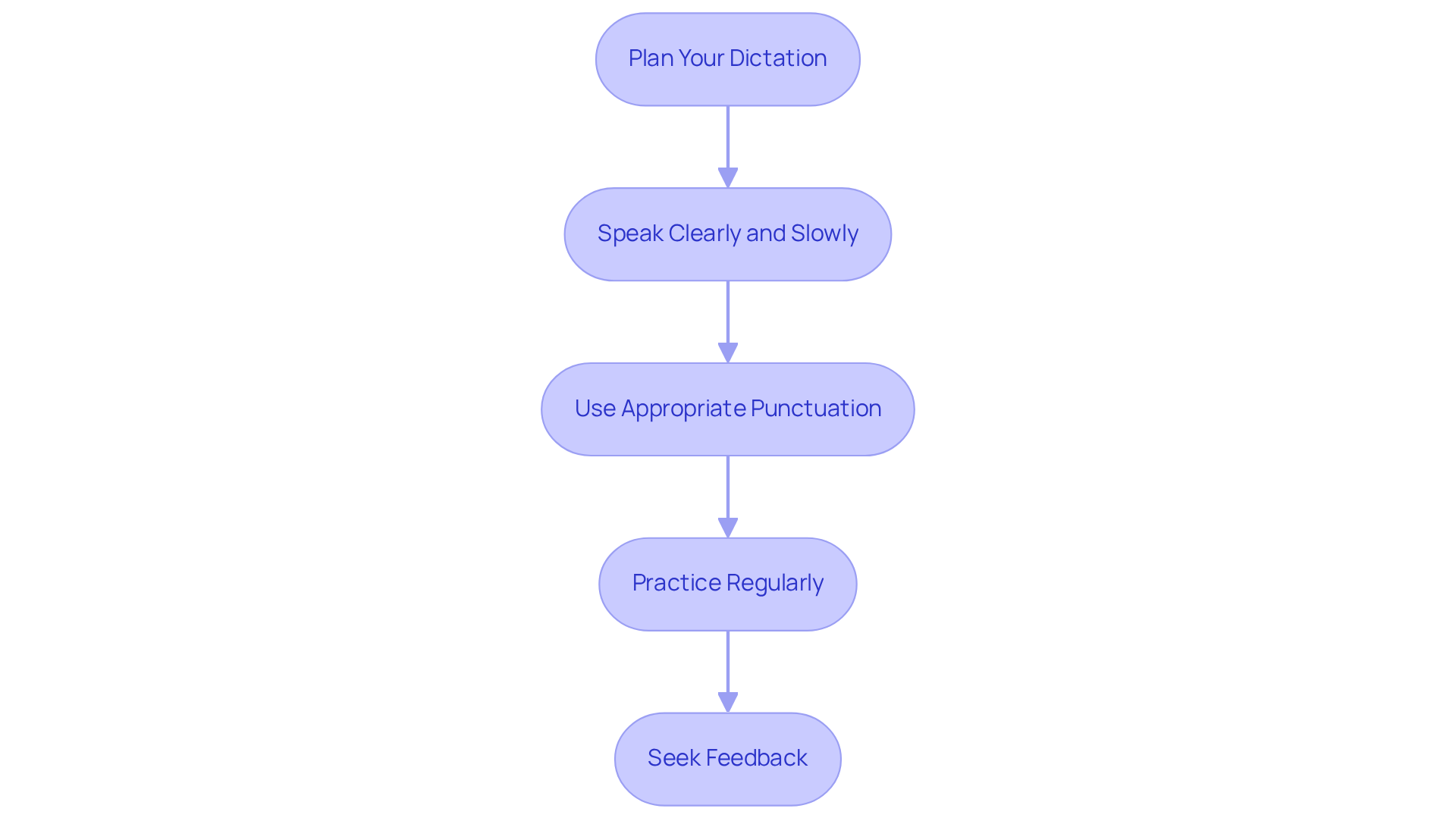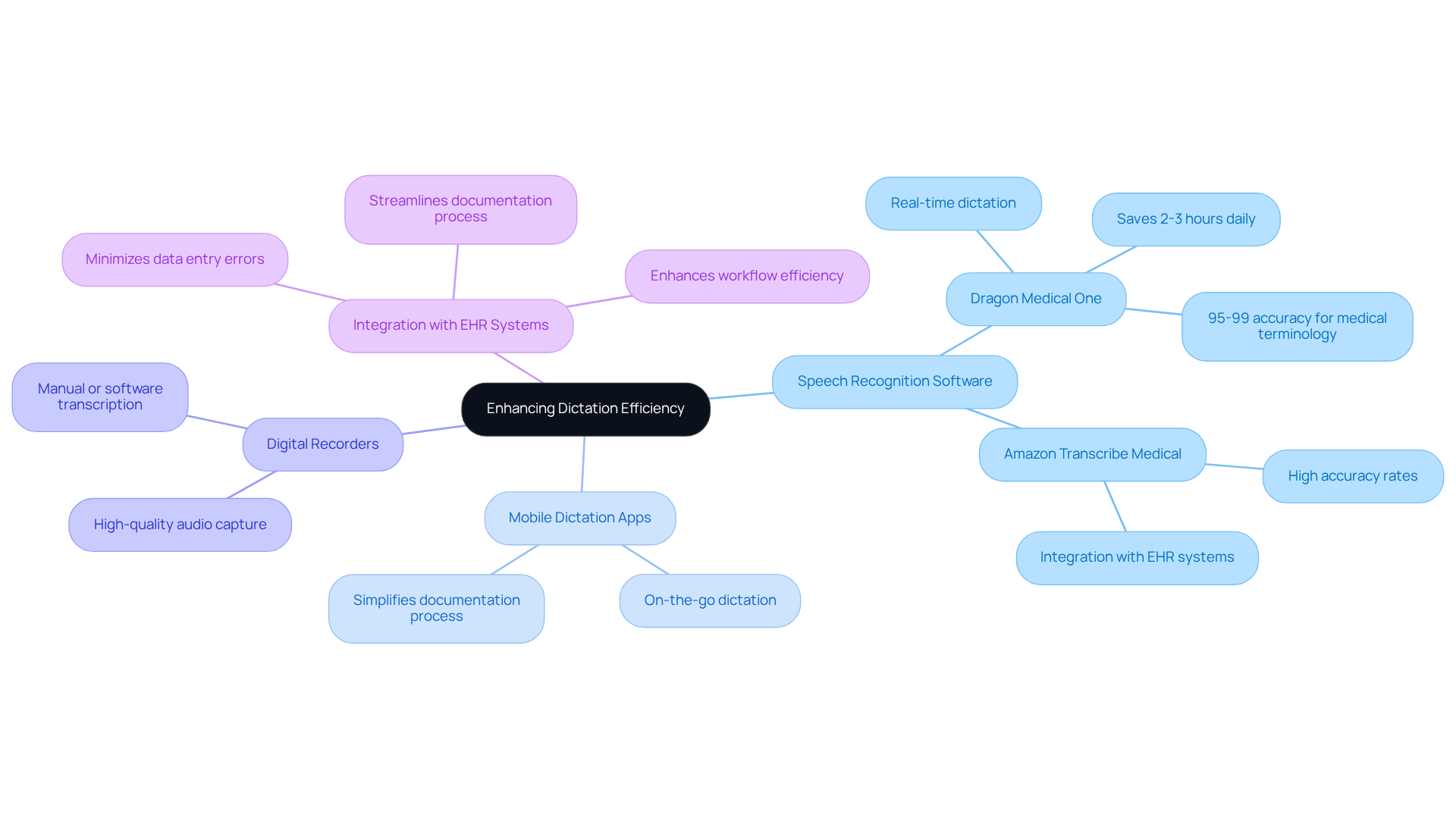Overview
In the demanding world of healthcare, providers often face overwhelming administrative burdens that can detract from the essential focus on patient care. This article outlines four essential steps for mastering doctors' dictation, aiming to alleviate some of these challenges and improve efficiency in medical practice.
Understanding medical terminology is crucial, as it forms the foundation for effective communication. Additionally, implementing effective dictation techniques can significantly streamline the documentation process. By leveraging technology, healthcare providers can further enhance their efficiency, making documentation less of a chore and more of a seamless part of their workflow.
However, it’s not uncommon to encounter challenges along the way. Troubleshooting these common obstacles is vital for maintaining a smooth operation. By following this comprehensive framework, healthcare providers can not only streamline their documentation processes but also enhance overall patient care.
Are you ready to take the next step towards a more efficient practice? Embrace these strategies to foster a more supportive environment for both yourself and your patients.
Introduction
Mastering the art of doctors' dictation is not just a skill; it’s a crucial part of delivering quality healthcare. As medical professionals navigate the increasing pressures of administrative tasks, the ability to record patient information effectively becomes essential. How often do these documentation demands feel overwhelming, even for the most experienced practitioners? By exploring the fundamentals of medical dictation, effective techniques, and the latest technological advancements, we can uncover new paths to efficiency and accuracy in practice.
Consider the emotional toll that administrative burdens can take on healthcare providers. These pressures can detract from the time and attention given to patient care. It’s vital to recognize how mastering dictation can alleviate some of these challenges, allowing for a more streamlined workflow. Imagine the relief of having more time to focus on what truly matters—your patients.
Let’s delve into effective strategies that can transform your documentation process. By adopting these techniques, you can enhance not only your efficiency but also the quality of care you provide. It’s time to embrace the tools that can help you thrive in your practice. Together, we can unlock new levels of accuracy and compassion in healthcare.
Understand the Basics of Medical Dictation
Doctors dictation is a crucial aspect of medical transcription in healthcare, involving the verbal recording of patient information—histories, diagnoses, and treatment plans—by healthcare providers. This process is essential not only for creating accurate medical records but also for alleviating the administrative burdens that often weigh heavily on physicians due to doctors dictation. Have you ever felt overwhelmed by paperwork? You're not alone. Understanding how to streamline this process can significantly enhance your practice.
- Terminology: It's vital to familiarize yourself with medical terminology. This knowledge ensures clarity and accuracy in your doctors dictation, enabling effective communication and precise record-keeping. When you speak the language of medicine, you foster better understanding and collaboration.
- Format: Grasping the standard formats for various medical reports—like progress notes, discharge summaries, and referral letters—is key. Utilizing the correct format not only aids in clarity but also enhances the efficiency of record-keeping, making your workflow smoother.
- Purpose: Remember, the main objective of transcription is to improve healthcare. By ensuring that all pertinent information is accurately recorded and readily available, you contribute to better patient outcomes. With the help of generative AI tools, such as voice recognition software and automated transcription services, you can . This allows you to focus more on your patients and less on administrative tasks.
By mastering these foundational aspects and embracing AI-driven transcription tools, you will be better equipped to implement effective doctors dictation methods in your practice. This not only enhances your efficiency but ultimately leads to improved patient satisfaction and outcomes. Let's take this step together toward a more manageable and fulfilling practice.

Implement Effective Dictation Techniques
Implementing effective dictation techniques can be a challenge in your busy routine, but with a few thoughtful steps, you can make this process smoother and more efficient:
- Plan Your Dictation: Before you begin, take a moment to outline the key points you want to cover. This not only helps you maintain focus but also ensures that no critical information slips through the cracks.
- Speak Clearly and Slowly: As you dictate, remember to enunciate your words and maintain a steady pace. This simple practice can significantly during transcription, making your spoken input much easier to understand.
- Use Appropriate Punctuation: Incorporating verbal cues for punctuation—like saying 'comma' or 'period'—can greatly enhance the clarity of your transcription, allowing for a smoother reading experience.
- Practice Regularly: Just like any other skill, regular practice is key. Consider setting aside time each week to hone your transcription skills, focusing on various types of reports to broaden your expertise.
- Seek Feedback: If you have the opportunity, ask a colleague to review your dictated notes. Their insights can help you identify areas for improvement, making your dictation even more effective.
By embracing these methods, you can not only enhance the quality of your transcription but also boost your overall efficiency in recording. Remember, every step you take towards improvement is a step towards better patient care.

Leverage Technology for Enhanced Dictation Efficiency
To enhance through technology, it’s essential to consider the emotional challenges faced by healthcare providers. Administrative burdens can weigh heavily, impacting not only their productivity but also the quality of care they provide. Here are some tools and techniques that can help ease these pressures:
- Speech Recognition Software: Implement advanced solutions like Dragon Medical One or Amazon Transcribe Medical. These tools convert spoken words into text in real-time, achieving accuracy rates of 95-99% for medical terminology. This significantly reduces the need for manual transcription in doctors dictation, allowing healthcare professionals to save up to 2-3 hours daily on documentation tasks. By automating these processes, providers can relieve administrative burdens associated with doctors dictation and focus more on patient care, addressing the urgent issue of physician burnout.
- Mobile Dictation Apps: Utilize mobile applications that enable dictation on-the-go. This flexibility allows you to capture client information whenever necessary, simplifying the documentation process and enhancing interactions with individuals.
- Digital Recorders: Invest in high-quality digital recorders that capture clear audio. This audio can be transcribed manually or through software, ensuring that important patient details are documented accurately and efficiently, ultimately enhancing the overall quality of care provided.
- Integration with EHR Systems: Choose transcription tools that seamlessly connect with your Electronic Health Record (EHR) system. This integration minimizes data entry errors and streamlines the documentation process, enhancing overall workflow efficiency. For instance, Dragon Medical One connects directly with top EHR systems, enabling real-time speech input into charts, which greatly lessens clinician fatigue and enhances workflow.
By utilizing these technologies, including generative AI solutions, healthcare providers can significantly enhance the efficiency and precision of their transcription processes. This improvement not only enhances patient care but also promotes operational productivity, paving the way for a more patient-centric healthcare delivery model. How can these tools fit into your daily routine to alleviate some of the stress you face? Let's explore these solutions together.

Troubleshoot Common Dictation Challenges
Addressing frequent transcription challenges is essential for maintaining high documentation standards in healthcare. It’s important to recognize the emotional strain these challenges can impose on healthcare providers. Here are some effective strategies that may ease this burden:
- Background Noise: Background noise can significantly hinder dictation accuracy, with studies showing it may reduce transcription precision by up to 30%. To alleviate this issue, consider seeking quieter environments for recording or investing in . These tools can enhance audio clarity and improve overall transcription quality, allowing you to focus more on patient care.
- Accurate Transcription: If your speech recognition software struggles with accuracy, remember to articulate your words clearly. Many advanced transcription tools, including CosmaNeura's AI, are designed to accurately process medical terminology and can achieve impressive accuracy rates of up to 99%. Moreover, these tools often allow for voice training, enhancing the software's ability to recognize your unique speech patterns, which can be a game-changer in your workflow.
- Time Management: To streamline the transcription process, practice pacing your speech and utilize templates for frequently used reports. This approach not only saves time but also ensures consistency in documentation. Additionally, incorporating speech recognition tools with Electronic Health Record (EHR) systems can automate data entry, further enhancing your efficiency and freeing up time for patient interactions.
- Technical Issues: Regularly updating your speech recognition software and hardware is vital to prevent compatibility problems. If you encounter persistent technical difficulties, don’t hesitate to reach out to technical support for assistance. Many AI transcription tools also include real-time error correction, providing immediate feedback to improve the accuracy of your records.
By proactively addressing these challenges, healthcare providers can significantly enhance their dictation efficiency. This allows you to focus more on what truly matters—patient care—while ensuring meticulous documentation. Remember, you are not alone in this journey; support and resources are available to help you thrive.

Conclusion
Mastering doctors' dictation is not just a skill; it's a pivotal journey toward enhancing the quality of healthcare delivery. Have you ever felt overwhelmed by administrative tasks? By effectively recording patient information, healthcare providers can alleviate these burdens, allowing for a greater focus on what truly matters—patient care. Embracing this skill streamlines documentation processes and fosters better communication and collaboration within the healthcare team.
Throughout this discussion, we’ve highlighted key strategies that can make a difference:
- Understanding medical terminology
- Implementing effective dictation techniques
- Leveraging advanced technology
- Troubleshooting common challenges
Each of these elements plays a crucial role in enhancing dictation efficiency, ultimately leading to improved patient outcomes and reduced clinician burnout. Imagine integrating tools such as speech recognition software and mobile dictation apps—these can save valuable time and enhance the accuracy of your records.
In reflection, the significance of mastering doctors' dictation extends beyond mere efficiency—it directly impacts the quality of patient care. By prioritizing effective documentation practices, healthcare professionals can reclaim their focus on patients, ensuring that they receive the attention and care they deserve. It’s essential to embrace these strategies and technologies, not only to improve personal workflow but to foster a healthcare environment that is more compassionate and patient-centered. Let’s take this step together, ensuring that every patient feels valued and cared for.




